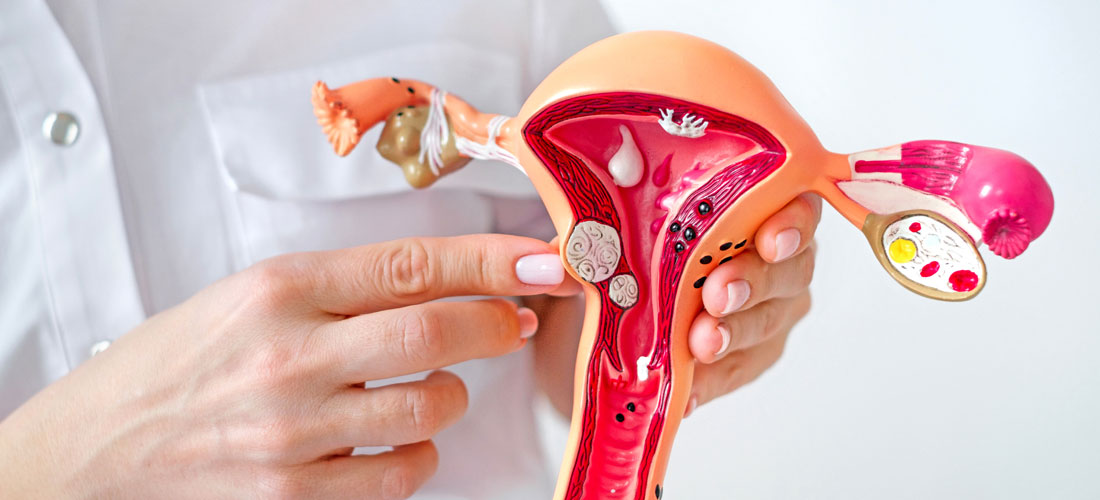Uterine Artery Embolization (UAE)
Adenomyosis is a condition that can dramatically affect your quality of life, causing heavy periods, debilitating cramps, and chronic pelvic pain. Yet, for many women, hysterectomy has long been the only option offered for relief.
At RIVEA Vascular Institute, we offer a modern alternative: Uterine Artery Embolization (UAE). It is a non-surgical, image-guided procedure that provides long-term symptom control without removing the uterus.
When is embolization performed?
Historically, hysterectomy (surgical removal of the uterus) has been the go-to treatment for adenomyosis, especially in women who don’t respond to medication. However, for women who wish to preserve their uterus, avoid major surgery, or prefer a faster recovery, UAE has emerged as a highly effective alternative.
UAE treats adenomyosis by blocking the arteries that supply blood to the diseased uterine tissue, causing it to shrink and die off over time. This results in:
- Reduction in uterine size
- Decreased bleeding
- Relief from pelvic pain and pressure
All of this is achieved without surgical incisions or general anesthesia.
Understanding Uterine Artery Embolization (UAE)
Who Is a Candidate for Embolization?
You may be a candidate for uterine artery embolization if:
- You’ve been diagnosed with adenomyosis (confirmed via MRI or ultrasound)
- You experience heavy, prolonged periods that disrupt daily life
- You suffer from pelvic pain, cramps, bloating, or pressure
- Hormonal medications haven’t worked or are not an option
- You wish to avoid hysterectomy and preserve your uterus
- You’re looking for a quicker, less invasive treatment option with minimal downtime
Preparing for Uterine Artery Embolization
UAE is a minimally invasive, image-guided procedure performed by an interventional radiologist. All patients undergo a consultation with Dr. Arjun Reddy, our expert interventional radiologist, to:
- Review your symptoms and medical history
- Assess imaging (ultrasound and MRI)
- Confirm adenomyosis diagnosis and UAE suitability
- An MRI may be recommended to confirm diagnosis, rule out malignancy, and serve as a baseline for future follow-ups.
What to Expect on the Day of UAE
- Avoid solid food for 6 hours prior to your procedure
- You will receive IV fluids, sedation, and pain relief
- A catheter is placed in the bladder for optimal imaging
- No general anesthesia is required
What Happens During the Procedure?
The procedure is performed through a tiny skin nick (1–2 mm) under local anesthesia:
- A thin catheter is inserted into an artery either in the wrist (radial artery) or groin (femoral artery).
- Under real-time X-ray guidance (fluoroscopy), the catheter is navigated into the uterine arteries that supply blood to the adenomyotic tissue.
- Once in position, embolic beads—biocompatible polyvinyl alcohol (PVA) particles—are injected through the catheter.
- These particles block the abnormal blood vessels feeding the adenomyosis, effectively cutting off oxygen and nutrients.
- As a result, the adenomyotic tissue gradually shrinks and breaks down, leading to long-term symptom relief.
The procedure is minimally invasive, uterus-sparing, and typically performed as a day-care or short-stay treatment.
After the Procedure:
- UAE is performed as a day-care procedure
- Most patients go home within a few hours
- Recovery is usually within 7–10 days
- Pain is managed with medications and a PCA (patient-controlled analgesia) pump if needed
- Vaginal discharge and minor bleeding are common and temporary
Why Uterine Artery Embolization may be the best choice
Compared to hysterectomy, UAE offers:
No surgical removal of uterus
Avoidance of general anesthesia
Shorter hospital stay and recovery
No visible scars
Lower risk of complications
Why choose RIVEA?
At RIVEA Vascular Institute, women with adenomyosis receive specialized, evidence-based care through advanced uterine artery embolization. Leading the program is Dr. Arjun Reddy, co-founder of RIVEA, widely recognized as one of Hyderabad’s top Interventional Radiologists. With cutting-edge imaging and catheterization technology, the institute ensures precision-guided embolization procedures that are both safe and effective, offering an organ-preserving alternative to hysterectomy.
What sets RIVEA apart:
- Allia IGS 7 hybrid imaging system for ultra-precise navigation, reduced radiation exposure, and safer minimally invasive procedures
- One of the top interventional radiologists in South India
- Expertise in complex, image-guided embolization for adenomyosis
- Patient-first approach for comfort, safety, and faster recovery
- Comprehensive care from initial diagnosis to long-term follow-up
Frequently Asked Questions (FAQs)
Will I still get my period after UAE?
Yes. Most women resume normal menstrual cycles following Uterine Artery Embolization. Some may experience temporary changes in bleeding patterns, including lighter periods or a brief pause. Permanent menopause is rare in women under the age of 40.
Can I get pregnant after UAE?
Pregnancy is possible after UAE, though outcomes vary depending on age, severity of adenomyosis, and individual fertility factors. UAE is not a fertility treatment, but many women have successfully conceived post-procedure. If preserving fertility is a priority, our team will help you explore all available options before proceeding.
Is the procedure painful?
The embolization procedure itself is not painful, as it is performed under local anesthesia and sedation. Mild to moderate cramping may occur afterward and is typically well-managed with prescribed pain relief medications.
What are the potential risks of uterine artery embolization?
Post-embolization syndrome: A common, self-limiting response that may include fever, nausea, fatigue, and mild flu-like symptoms for a few days.
Pelvic pain or cramping: Typically mild to moderate and managed with medication.
Infection: Occurs in approximately 2–3% of cases and is usually treatable with antibiotics.
Ovarian dysfunction: Uncommon in women under 40 (1–3%), but the risk may be higher in women over 45.
Impact on fertility: UAE can preserve the uterus, but future pregnancy is not guaranteed. Women desiring fertility should discuss this in detail with their interventional radiologist.
These risks are rare and generally manageable, making UAE a highly favorable option for women seeking non-surgical treatment for adenomyosis.
What are the embolic particles used?
At RIVEA, we use high-quality, biocompatible polyvinyl alcohol (PVA) particles. These microscopic beads are inert and have been safely used in medical procedures for decades to selectively block blood flow to abnormal tissue.
Are follow-ups necessary?
Yes. Post-procedure follow-up is essential. We typically recommend:
- A check-in at 3 months to assess early symptom response.
- A follow-up MRI at 6 months to evaluate treatment success and tissue changes.
What symptoms should I monitor after UAE?
Mild bleeding or brown discharge is common during recovery. However, you should promptly report symptoms such as:
- Persistent or high fever
- Foul-smelling vaginal discharge
- Severe or worsening pelvic pain
These may indicate a complication and require immediate attention.
What results can I expect after UAE?
Clinical studies show that 75–85% of women experience substantial relief from adenomyosis symptoms after UAE. You can expect:
- Lighter, more manageable periods
- Reduced pelvic pain and pressure
- Improved energy and daily activity levels
- Symptom improvement within 3–6 months as the adenomyotic tissue gradually shrinks
- No large surgical wounds or hospital stay
Most importantly, UAE preserves the uterus—an essential benefit for many women, regardless of future pregnancy plans.
How safe is UAE?
When performed by a skilled interventional radiologist in a specialized center like RIVEA, UAE is a very safe, well-established procedure. Compared to hysterectomy or other major surgeries, UAE carries significantly lower risks.
Potential risks may include:
- Post-embolization syndrome (mild fever, fatigue, nausea)
- Mild pelvic discomfort or cramping
- Rare risk of infection
- Early menopause, particularly in women over 45
If you are living with heavy bleeding, chronic pelvic pain, or pressure due to adenomyosis and wish to avoid major surgery, Uterine Artery Embolization may be a safe, effective option for you.
Our team at RIVEA is here to guide you through every step of the decision-making process. Contact Us
Click here to learn more about:
Uterine Artery Embolization for Adenomyosis
For any inquiries, post your query here:
Ask Rivea
Contact us today to explore your options.
Call Now
Our Team
-

Dr. Arjun Reddy
MBBS, MD
Chief Interventional RadiologistDr. Arjun Reddy is a highly accomplished Interventional Radiologist with extensive international training and a track record of pioneering minimally invasive, image-guided procedures in India.
View Profile Book an Appointment
Blog
Media



